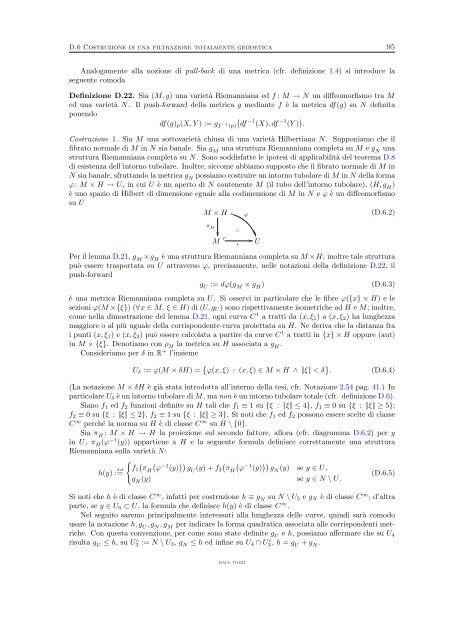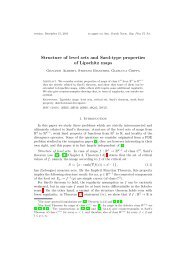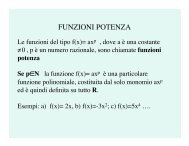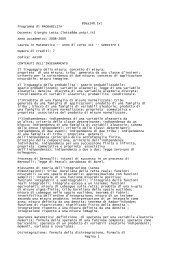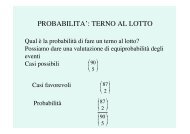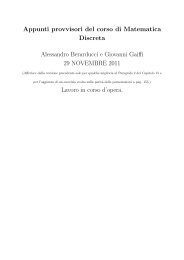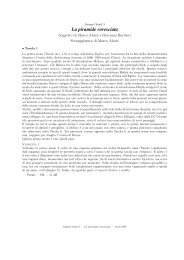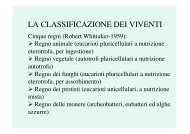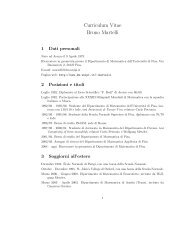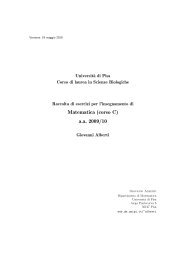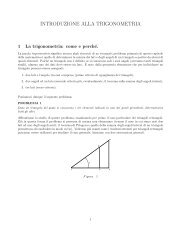Immersioni aperte in dimensione infinita - Dipartimento di Matematica
Immersioni aperte in dimensione infinita - Dipartimento di Matematica
Immersioni aperte in dimensione infinita - Dipartimento di Matematica
Create successful ePaper yourself
Turn your PDF publications into a flip-book with our unique Google optimized e-Paper software.
D.6 Costruzione <strong>di</strong> una filtrazione totalmente geodetica 95<br />
Analogamente alla nozione <strong>di</strong> pull-back <strong>di</strong> una metrica (cfr. def<strong>in</strong>izione 1.4) si <strong>in</strong>troduce la<br />
seguente comoda<br />
Def<strong>in</strong>izione D.22. Sia (M, g) una varietà Riemanniana ed f : M → N un <strong>di</strong>ffeomorfismo tra M<br />
ed una varietà N. Il push-forward della metrica g me<strong>di</strong>ante f è la metrica df(g) su N def<strong>in</strong>ita<br />
ponendo<br />
−1 −1<br />
df(g)p(X, Y ) := gf −1 (p) df (X), df (Y ) .<br />
Costruzione 1. Sia M una sottovarietà chiusa <strong>di</strong> una varietà Hilbertiana N. Supponiamo che il<br />
fibrato normale <strong>di</strong> M <strong>in</strong> N sia banale. Sia g M una struttura Riemanniana completa su M e g N una<br />
struttura Riemanniana completa su N. Sono sod<strong>di</strong>sfatte le ipotesi <strong>di</strong> applicabilità del teorema D.8<br />
<strong>di</strong> esistenza dell’<strong>in</strong>torno tubolare. Inoltre, siccome abbiamo supposto che il fibrato normale <strong>di</strong> M <strong>in</strong><br />
N sia banale, sfruttando la metrica g N possiamo costruire un <strong>in</strong>torno tubolare <strong>di</strong> M <strong>in</strong> N della forma<br />
ϕ: M × H → U, <strong>in</strong> cui U è un aperto <strong>di</strong> N contenente M (il tubo dell’<strong>in</strong>torno tubolare), (H, g H )<br />
è uno spazio <strong>di</strong> Hilbert <strong>di</strong> <strong><strong>di</strong>mensione</strong> eguale alla co<strong><strong>di</strong>mensione</strong> <strong>di</strong> M <strong>in</strong> N e ϕ è un <strong>di</strong>ffeomorfismo<br />
su U<br />
M × H <br />
ϕ<br />
π M<br />
<br />
<br />
M<br />
<br />
ι<br />
<br />
<br />
U<br />
(D.6.2)<br />
Per il lemma D.21, g M ×g H è una struttura Riemanniana completa su M ×H; <strong>in</strong>oltre tale struttura<br />
può essere trasportata su U attraverso ϕ, precisamente, nelle notazioni della def<strong>in</strong>izione D.22, il<br />
push-forward<br />
g U := dϕ(g M × g H) (D.6.3)<br />
è una metrica Riemanniana completa su U. Si osservi <strong>in</strong> particolare che le fibre ϕ({x} × H) e le<br />
sezioni ϕ(M ×{ξ}) (∀x ∈ M, ξ ∈ H) <strong>di</strong> (U, gU ) sono rispettivamente isometriche ad H e M; <strong>in</strong>oltre,<br />
come nella <strong>di</strong>mostrazione del lemma D.21, ogni curva C 1 a tratti da (x, ξ1) a (x, ξ2) ha lunghezza<br />
maggiore o al più uguale della corrispondente curva proiettata su H. Ne deriva che la <strong>di</strong>stanza fra<br />
i punti (x, ξ1) e (x, ξ2) può essere calcolata a partire da curve C 1 a tratti <strong>in</strong> {x} × H oppure (aut)<br />
<strong>in</strong> M × {ξ}. Denotiamo con ρ H la metrica su H associata a g H .<br />
Consideriamo per δ <strong>in</strong> R + l’<strong>in</strong>sieme<br />
Uδ := ϕ(M × δH) = ϕ(x, ξ) : (x, ξ) ∈ M × H ∧ |ξ | < δ . (D.6.4)<br />
(La notazione M × δH è già stata <strong>in</strong>trodotta all’<strong>in</strong>terno della tesi, cfr. Notazione 2.54 pag. 41.) In<br />
particolare Uδ è un <strong>in</strong>torno tubolare <strong>di</strong> M, ma non è un <strong>in</strong>torno tubolare totale (cfr. def<strong>in</strong>izione D.6).<br />
Siano f1 ed f2 funzioni def<strong>in</strong>ite su H tali che f1 ≡ 1 su {ξ : |ξ | ≤ 4}, f1 ≡ 0 su {ξ : |ξ | ≥ 5};<br />
f2 ≡ 0 su {ξ : |ξ | ≤ 2}, f2 ≡ 1 su {ξ : |ξ | ≥ 3}. Si noti che f1 ed f2 possono essere scelte <strong>di</strong> classe<br />
C ∞ perché la norma su H è <strong>di</strong> classe C ∞ su H \ {0}.<br />
Sia π H : M × H → H la proiezione sul secondo fattore, allora (cfr. <strong>di</strong>agramma D.6.2) per y<br />
<strong>in</strong> U, π H (ϕ −1 (y)) appartiene a H e la seguente formula def<strong>in</strong>isce correttamente una struttura<br />
Riemanniana sulla varietà N:<br />
h(y) : def<br />
=<br />
<br />
−1 −1<br />
f1 πH ϕ (y) gU (y) + f2 πH ϕ (y) gN (y) se y ∈ U,<br />
gN (y) se y ∈ N \ U.<br />
(D.6.5)<br />
Si noti che h è <strong>di</strong> classe C ∞ , <strong>in</strong>fatti per costruzione h ≡ g N su N \ U5 e gN è <strong>di</strong> classe C ∞ ; d’altra<br />
parte, se y ∈ U6 ⊂ U, la formula che def<strong>in</strong>isce h(y) è <strong>di</strong> classe C ∞ .<br />
Nel seguito saremo pr<strong>in</strong>cipalmente <strong>in</strong>teressati alla lunghezza delle curve, qu<strong>in</strong><strong>di</strong> sarà comodo<br />
usare la notazione h, g U , g N , g M per <strong>in</strong><strong>di</strong>care la forma quadratica associata alle corrispondenti metriche.<br />
Con questa convenzione, per come sono state def<strong>in</strong>ite g U e h, possiamo affermare che su U4<br />
risulta g U ≤ h, su U c 3 := N \ U3, g N ≤ h ed <strong>in</strong>f<strong>in</strong>e su U4 ∩ U c 3, h = g U + g N .<br />
RAUL TOZZI


